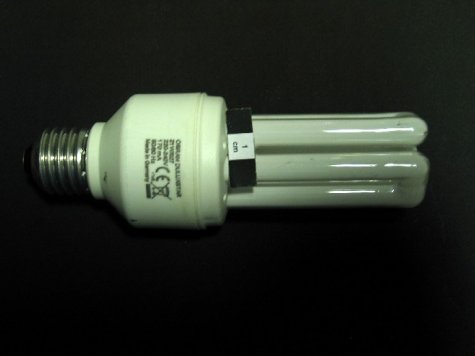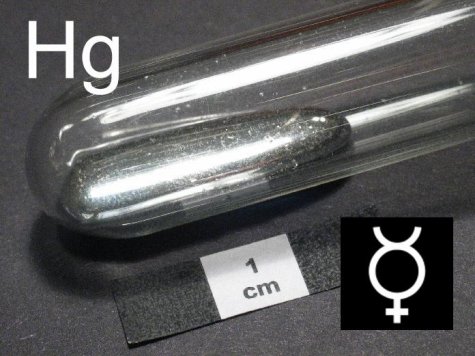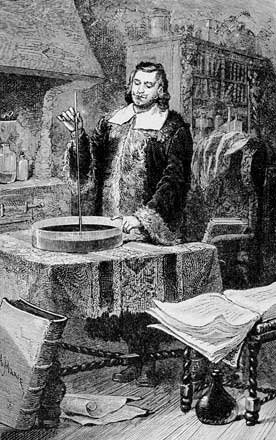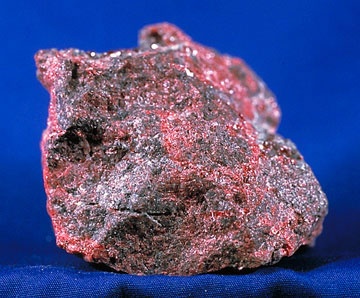Hydrargyrum. Mercury. Hg as chemical symbol. Translated from Latin word-by-word “water silver” or “liquid silver”: this nicely sums up the visible character of this element (Photo 1). Mercury is the only elementary metal that is liquid at room temperature (although alloys made of several metals can be so too). Man has known mercury for a long time – the metal was known in ancient China, India and Egypt. And it is no wonder that the alchemists used the planet Mercurius (named for the messenger of the gods, the fleet-footed Hermes-Mercurius) as the sign of mercury (Photo 1, lower right-hand corner).
Photo 2. A steel bearing ball floating on the surface of mercury.
In normal conditions mercury, with a density of 13,5 g/cm3, has the highest known density of all liquids. So a steel bearing ball (density 7,9 g/cm3) will for instance float on the surface of mercury and does not sink (Photo 2). For an observant watcher the photo might however raise a question that is discussed further on.
Photo 3. Evangelista Torricelli (1608 - 1647) demonstrating his mercury barometer.
Mercury has given man two important measuring devices – the thermometer and the barometer. In 1643 the Italian physicist Evangelista Torricelli made this experiment: he filled a glass tube, sealed at one end, with mercury and placed it with its open end in a vessel with mercury (Photo 3). The mercury column in the tube dropped downwards, and a vacuum (or to be precise, a space filled with mercury vapour) was created in its place at the sealed end; the height of the column in the tube stayed at about 760 mm above the surface of the mercury in the vessel. The exact height depends on the air pressure. So the mercury barometer was born. And from this the common unit for atmospheric pressure also originates – millimetres of mercury column (mm Hg). Looking at the figure Torricelli’s audacity must be admired (or one might say – his disregard of all safety techniques) – but at that time knowledge of the toxic effects of mercury vapours was much more scanty than today.
The thermal expansion of mercury has found its use in thermometers. We all probably have noticed one difference between the alcohol thermometer outside the window that shows the temperature outside, and the fever thermometer that Mum used to check our fever. When a cool night follows a hot summer day, the alcohol column will fall – by precisely as much as the air cools.

Photo 4. Broken (discontinuous) mercury column in the capillary of a fever thermometer.
But the fever tally will remain on the fever thermometer; the thermometer must be shaken to bring it down to its original level (this type of thermometer is called a maximum thermometer). A close look at the “neck” of the thermometer reveals that in a cooled-down thermometer of this kind the mercury column has a gap in the narrowest part (Photo 4). What broke the column? To understand this, we must return to Photo 2. The observer might have noted that a much smaller part of the ball is actually submerged than could be expected from the difference in densities (this would leave barely half of the ball above the mercury).
Photo 5. Steel bearing ball in mercury-filled ampoule seen from the bottom.
An even greater surprise would be in store for an observer who somehow manages to force the ball down into the mercury, to the bottom of the test vessel. With an iron bearing ball this can be done comparatively easily and safely for instance by placing a magnet beneath the container with mercury. When the magnet is then carefully withdrawn, the ball … stays on the bottom of the container! It really stays there – as shown from below in Photo 5. The explanation to the puzzle of the steel ball’s behaviour as well as the broken mercury column is the same – surface tension. The surface tension of mercury it is about 7 times higher than of water. We know that small objects denser than water, that are not wetted by water, can float on the water surface – the surface tension forces press them out of the water (Photo 6).
Photo 6. Aluminium coins that are not wetted by water floating on a water surface.
Mercury does not wet iron – thus the bearing floats on the surface almost without dipping into it. And the opposite –once the bearing is submerged, the surface tension forces press it towards the bottom, and do not allow it to rise.
The surface energy associated with the surface tension forces is proportional to the size of the surface area: thus it “pays” for the mercury column in the capillary neck of the thermometer to break. Two new surfaces will be created, but the contact area of mercury with glass will still be clearly reduced.
Mercury is not only dangerous for humans but also for … aluminium. Although aluminium is chemically a very reactive element, it is usually protected from extensive corrosion by the dense oxide layer (Al2O3) that forms on the metal surface. This limits the access of more oxygen to the metallic surface. If however this protective layer is damaged, and the aluminium in the place of damage is brought in contact with mercury (just an almost microscopic drop is sufficient) an intense corrosion will begin
.

Photo 7. A feathery “beard” of aluminium oxide crystals at the end of an aluminium wire. The tip had been cleaned and then brought in contact with mercury.
Outwardly this shows as the formation of extremely fragile, feathery “clouds” of oxide crystals (Photo 7) which can be fragmented by the slightest movement of air. Their formation however cannot be stopped by anything as long as the aluminium is in contact with mercury.
What happens?
Aluminium, as many other metals (but not iron – see Photos 2 and 4) dissolves easily in mercury, forming amalgams as a result. On the surface of the amalgam drop no protective, dense aluminium oxide layer will develop, so when the aluminium atoms come in contact with the oxygen in air, fragile masses of aluminium oxide crystals will form. And the aluminium atoms so removed from the amalgam in the drop will be replaced again and again by new aluminium atoms from the metal dissolving in the mercury. The mercury itself is not consumed in this process, it only provides a suitable reaction environment. This is another good reason, in addition to its toxic effect, for not allowing mercury-containing devices to be brought on board an aeroplane
!

Photo 8. Dutch physicist Heike Kammerlingh-Onnes (1853 – 1926) – discoverer of superconductivity..
The University of Leyden, the Netherlands. The year is 1911. Heike Kammerlingh-Onnes (Photo 8) studies the conductivity of metals at low temperatures. Measurements on mercury show amazing results: as the temperature of the mercury column falls below 4,2 K the electrical resistance of the column drops suddenly to zero. Mercury has presented mankind with a new phenomenon – superconductivity - and its discoverer with a quickly awarded Nobel prize (1913). Today superconductivity has been found in many other materials and also at notably higher temperatures. But this will have its own story.
Photo 9. The mercury ore cinnabar (HgS).
Mercury does occur in its elementary form in nature, although not in such amounts as in the story “The lake of the mountain spirits” (in the collection “Five rombs”) by Russian sci-fi writer Ivan Jefremov; there are only microscopic droplets in certain mercury-bearing rocks. The source of industrial mercury is its sulphide (HgS) – cinnabar (Photo 9). The production of mercury in the world is however going down due to decreasing demand as well as the depletion of resources. The toxic effect of mercury (mercury vapours) is the reason why many devices based on mercury (thermometers, barometers) have been replaced by other technical solutions. The price of this understanding has however been a great number of cases of poisoning, some of them on a very large scale. A very good survey on this theme (and much more of interest about mercury) is given in Herki Karik’s excellent book “Inventions and discoveries in chemistry”. Yet there is one area of use, where a technical solution involving mercury is replacing the “mercury-free” alternative. We are talking about the fluorescent energy-saving bulbs replacing the incandescent bulbs (Photo 10).

Photo 10. Energy-saving bulb. The illuminating power of this 20 W bulb is equal to that of an 100 W conventional incandescent bulb.
True, such a lamp only contains a minimal amount of mercury (ca 5 mg) and the energy shortage problems torment mankind ever more seriously.
As before, there is more information in “Materjalimaailm” (Materials world) – heading “Elavhõbe” (Mercury)
.

















